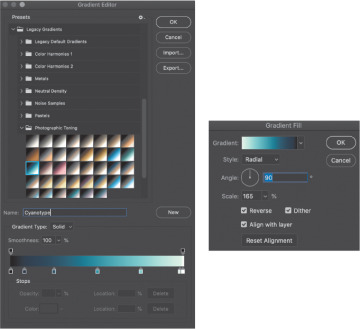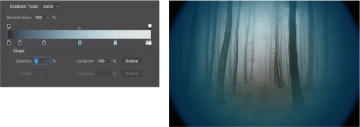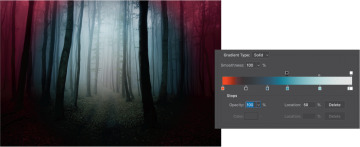Creative Vignettes
Vignettes use the same basic principles as the graduated neutral density techniques, but applying them is much more of a creative endeavor than a corrective one. As such, the possible variations open up quite dramatically. Honestly, anything you do to change the value around the perimeter of your image with the intent of drawing focus to your subject counts as a vignette. Of course, some methods are more popular than others.

To illustrate the concept, let’s grab the Gradient tool and choose a Foreground To Transparent gradient with the Radial style. You may have to switch your foreground color to black, and in the options bar select the Transparency option. Also ensure Reverse is checked in the options. On a blank layer above your image, drag from center of the canvas to any edge. Name this layer Vignette for now.
Without blending modes applied to the Vignette layer, the result is predictably dark, but satisfies the basic description of a vignette. In fact, a solid, unblended look is more traditional to vintage film photography. On the Vignette layer, press Command+I (macOS)/Ctrl+I (Windows) to invert the black to white.
There is nothing that requires a vignette to be anything other than something to obscure the border of an image, and even that is not truly necessary. To that end, you can employ shape, color, and size in any way you as the artist see fit. Using the white vignette as on the previous page evokes old-style prints and can be useful in selling an idea of history in your work, especially with toning techniques like Sepia or Selenium (examples of which can be found in the “Color & Value” chapter).
Moving on to a more robust workflow, let’s add a Gradient Fill adjustment layer at the top of the layer stack (you’ll delete the Vignette layer later). When you first add a Gradient Fill adjustment layer to your document, the Gradient Fill dialog box pops up with a few controls. Choose Radial from the Style menu, then select the Reverse option (it may still be selected if you followed the previous technique). Finally, open the Gradient Editor by clicking the gradient swatch itself. Move the dialog box around so you can see the results of your changes immediately on the canvas.
For this example, I’m using the Cyanotype preset from the Photographic Toning collection (see Note). Because the gradient layer needs to have a transparent region but the preset is 100% opaque, we can either use a mask on the Gradient Fill layer or build some transparency into the gradient itself. To be more flexible, let’s create a new preset with its own transparency. The stops at the top of the gradient preview bar are for opacity. In this case, we want to make the white region transparent; click on the Opacity stop above the right edge of the bar, then change the Opacity setting at the bottom of the window to 0%.
I find in many cases that I prefer to move each of the color stops to the left to control the size of the gradient. That way the colors from the original gradient are still included. Before I close the Gradient Editor, I want to save the new gradient as a preset. Choosing New lets me save the preset, and I can drag it to any collection in the editor window.
Closing the Gradient Editor window takes us back to the Gradient Fill box, where we can do some additional refinement by adjusting the Scale so that the effect is pushed out more towards the edges. There is one more thing we want to do before closing this dialog box.
With the Gradient Fill box open, deselect “Align With Layer” so you can drag the gradient around on the screen. That way you aren’t locked in to having the center of the vignette right in the middle of your image. Also try out the Angle settings to see the effect on the shape of the vignette; for radial gradients, this changes the shape from circular to oval. Drag the gradient where you like, and click OK to close the dialog box. If you need to reposition it, you’ll have to open the Gradient Fill box again by double-clicking the adjustment layer icon.
With the gradient in place, you can change the opacity and blending to finish the effect. For this image, I chose to reduce the opacity to around 50%, and set the blending mode to Overlay to preserve the burning effect from the black areas.
While this result looks pretty good, we can make it even more stylized by changing up the gradient a bit. Back in the Gradient Editor, I’ll change the far-left Black color stop to a bright red (RGB: 255, 5, 50), then move the 100% Opacity stop to about the midway point. A few other color stop moves, and here’s the new result.
Because I made changes to the previous preset, I can save a new one as well to the same collection. This also gives me an excuse to remind you of a great trick using Libraries. Starting in Photoshop 2020, you can see your new presets in the Gradients panel (Window > Gradients) and simply click one to load it into a Gradient Fill layer. The problem is that the radial style is not preserved, nor is the scaling. When you go to apply your saved preset, you’ll have to make those settings changes. To get around this, you can drag your entire Gradient Fill layer to a Creative Cloud Library. Whenever you want to use it again, just drag it out to your Layers panel while holding Opt/Alt, and—boom!—instant stylized vignette.
Of course, you are not limited to gradients. It’s entirely possible to create vignettes with painting techniques. Turn off or delete the previous vignette and fill layers, and add a fresh, blank layer. Select the Brush tool, grab a large soft brush, and lower the opacity to around 30%, and the flow to 10%. This will allow you to scrub and color in the effect a little more carefully.
Hold Opt/Alt to temporarily switch to the Color Sample tool, and click to select any color you’d like to try for the border. Release the modifier key and begin painting along the same edge you sampled from. Let the paint build up a little at a time, focusing on removing distracting details from the edges of your photo, or drawing focus towards the subject. This is a good technique to start with to ensure some harmony among the colors in your image, but you do have to choose carefully.
With the paint layer still active, try out some of the blending modes. Color is a good one for supporting a particular palette, building a theme across several images, or connecting the image to a viewing environment. Color Burn, as used in the Neutral Density Gradient, will provide a dramatic darkening effect. Continue painting the other edges using the sampling method or using completely different colors as you go.
Remember: the point of adding vignettes is to enhance your photo by leading focus, and that means reducing visual clutter away from the subject.









